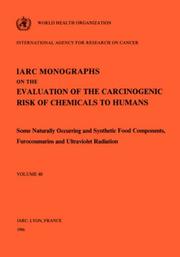| Listing 1 - 5 of 5 |
Sort by
|

ISBN: 012059515X Year: 1988 Publisher: London Academic press
Abstract | Keywords | Export | Availability | Bookmark
 Loading...
Loading...Choose an application
- Reference Manager
- EndNote
- RefWorks (Direct export to RefWorks)
Quinolines. --- #Lilly --- Quinolone antibacterial agents. --- Quinolinones. --- Quinolone antibacterial agents --- Quinolines --- Ketoquinolines --- Oxoquinolines --- Quinolinones --- Quinolone antimicrobial agents --- Quinolones --- Antibacterial agents --- Synthetic drugs

ISBN: 9283212401 Year: 1986 Volume: vol 40 Publisher: Lyon International Agency for Research on Cancer
Abstract | Keywords | Export | Availability | Bookmark
 Loading...
Loading...Choose an application
- Reference Manager
- EndNote
- RefWorks (Direct export to RefWorks)
Oncology. Neoplasms --- Toxicology --- Carbolines --- Carcinogens. --- Food Additives --- Imidazoles --- Mycotoxins --- Furocoumarins --- Quinolines --- Ultraviolet Rays --- 547.587.51 --- Oncogens --- Tumor Initiators --- Tumor Promoters --- Initiators, Tumor --- Promoters, Tumor --- Benzidines --- toxicity. --- adverse effects. --- Coumarin. Coumarinic acid. Coumaric acid. Thiocoumarin --- Conferences - Meetings --- 547.587.51 Coumarin. Coumarinic acid. Coumaric acid. Thiocoumarin --- Carcinogen --- Oncogen --- Tumor Initiator --- Tumor Promoter --- Initiator, Tumor --- Promoter, Tumor --- Carcinogens --- toxicity --- adverse effects
Book
Year: 2021 Publisher: Basel, Switzerland MDPI - Multidisciplinary Digital Publishing Institute
Abstract | Keywords | Export | Availability | Bookmark
 Loading...
Loading...Choose an application
- Reference Manager
- EndNote
- RefWorks (Direct export to RefWorks)
Heterocycles feature widely in natural products, agrochemicals, pharmaceuticals and dyes, and their synthesis is of great interest to synthetic chemists in both academia and industry. The contributions of recent applications of new methodologies in C–H activation, photoredox chemistry, cross-coupling strategies, borrowing hydrogen catalysis, multicomponent and solvent-free reactions, regio- and stereoselective syntheses, as well as other new, attractive approaches for the construction of heterocyclic scaffolds are of great interest. This Special Issue is dedicated to featuring the latest research that is ongoing in the field of heterocyclic synthesis. It is expected that most submissions will focus on five- and six-membered oxygen and nitrogen-containing heterocycles, but structures incorporating other rings/heteroatoms will also be considered. Original research (communications, full papers and reviews) that discusses innovative methodologies for assembling heterocycles with potential application in materials, catalysis and medicine are therefore welcome.
Medicine --- amine nucleophiles --- alkynoic acids --- cascade reaction --- gold catalysis --- fused N-heterocycles --- solid-phase synthesis --- ketone --- traceless synthesis --- natural products --- enol ethers --- photocatalysis --- photoredox --- visible-light-induced catalysis --- photoredox cyclization --- organic dyes --- heterocycles --- dihydrocoumarins --- synthesis --- 3-trifluoroacetyl coumarins --- phenols --- antifungal activities --- terpyridines --- 3,2':6',3"-terpyridine --- cyclohexanol derivative --- condensation --- heterocyclic --- 1,2,3-triazol --- triazolylmethyl phosphinate --- triazolylmethyl phosphate --- copper-catalyzed azide-alkyne cycloaddition --- click reaction --- azides --- cinnolines --- triazoles --- CuAAC --- alkynes --- cycloalkynes --- Richter cyclization --- Suzuki coupling --- fluorescence --- cytotoxicity --- coumarin --- pyrazolo[3,4-b]pyridine --- silica sulfuric acid --- 2H-pyran --- valence isomerism --- 1-oxa-triene --- dienone --- oxa-electrocyclization --- Knoevenagel --- propargyl Claisen --- cycloisomerization --- asymmetric dimeric β-carboline --- acylhydrazone group --- cytotoxic --- antitumor --- structure-activity relationship --- γ-lactam --- pyrrolidones --- multicomponent reactions --- organocatalysis --- pyridine --- CF3CO-acetylenes --- 1,3-oxazines --- fluorinated heterocycles --- saturated oxygen heterocycles --- cyclic ethers --- total synthesis --- multicomponent reaction --- α-halohydrazones --- Staudinger reaction --- aza-Wittig --- 1H-imidazole-2(3H)-thione --- 2H-imidazo[2,1-b][1,3,4]thiadiazine --- purine --- nucleobase --- aromatic substitution --- arylation --- fluoroalcohol --- α-chloroglycinates --- 5-acylamino-1,3-thiazoles --- Hantzsch reaction --- TMSBr --- propargylic alcohols --- cascade cyclization --- 4-bromo quinolines --- synthesis of benzofurans --- intra-molecular approach --- inter-molecular approach --- amine nucleophiles --- alkynoic acids --- cascade reaction --- gold catalysis --- fused N-heterocycles --- solid-phase synthesis --- ketone --- traceless synthesis --- natural products --- enol ethers --- photocatalysis --- photoredox --- visible-light-induced catalysis --- photoredox cyclization --- organic dyes --- heterocycles --- dihydrocoumarins --- synthesis --- 3-trifluoroacetyl coumarins --- phenols --- antifungal activities --- terpyridines --- 3,2':6',3"-terpyridine --- cyclohexanol derivative --- condensation --- heterocyclic --- 1,2,3-triazol --- triazolylmethyl phosphinate --- triazolylmethyl phosphate --- copper-catalyzed azide-alkyne cycloaddition --- click reaction --- azides --- cinnolines --- triazoles --- CuAAC --- alkynes --- cycloalkynes --- Richter cyclization --- Suzuki coupling --- fluorescence --- cytotoxicity --- coumarin --- pyrazolo[3,4-b]pyridine --- silica sulfuric acid --- 2H-pyran --- valence isomerism --- 1-oxa-triene --- dienone --- oxa-electrocyclization --- Knoevenagel --- propargyl Claisen --- cycloisomerization --- asymmetric dimeric β-carboline --- acylhydrazone group --- cytotoxic --- antitumor --- structure-activity relationship --- γ-lactam --- pyrrolidones --- multicomponent reactions --- organocatalysis --- pyridine --- CF3CO-acetylenes --- 1,3-oxazines --- fluorinated heterocycles --- saturated oxygen heterocycles --- cyclic ethers --- total synthesis --- multicomponent reaction --- α-halohydrazones --- Staudinger reaction --- aza-Wittig --- 1H-imidazole-2(3H)-thione --- 2H-imidazo[2,1-b][1,3,4]thiadiazine --- purine --- nucleobase --- aromatic substitution --- arylation --- fluoroalcohol --- α-chloroglycinates --- 5-acylamino-1,3-thiazoles --- Hantzsch reaction --- TMSBr --- propargylic alcohols --- cascade cyclization --- 4-bromo quinolines --- synthesis of benzofurans --- intra-molecular approach --- inter-molecular approach
Book
Year: 2021 Publisher: Basel, Switzerland MDPI - Multidisciplinary Digital Publishing Institute
Abstract | Keywords | Export | Availability | Bookmark
 Loading...
Loading...Choose an application
- Reference Manager
- EndNote
- RefWorks (Direct export to RefWorks)
Heterocycles feature widely in natural products, agrochemicals, pharmaceuticals and dyes, and their synthesis is of great interest to synthetic chemists in both academia and industry. The contributions of recent applications of new methodologies in C–H activation, photoredox chemistry, cross-coupling strategies, borrowing hydrogen catalysis, multicomponent and solvent-free reactions, regio- and stereoselective syntheses, as well as other new, attractive approaches for the construction of heterocyclic scaffolds are of great interest. This Special Issue is dedicated to featuring the latest research that is ongoing in the field of heterocyclic synthesis. It is expected that most submissions will focus on five- and six-membered oxygen and nitrogen-containing heterocycles, but structures incorporating other rings/heteroatoms will also be considered. Original research (communications, full papers and reviews) that discusses innovative methodologies for assembling heterocycles with potential application in materials, catalysis and medicine are therefore welcome.
Medicine --- amine nucleophiles --- alkynoic acids --- cascade reaction --- gold catalysis --- fused N-heterocycles --- solid-phase synthesis --- ketone --- traceless synthesis --- natural products --- enol ethers --- photocatalysis --- photoredox --- visible-light-induced catalysis --- photoredox cyclization --- organic dyes --- heterocycles --- dihydrocoumarins --- synthesis --- 3-trifluoroacetyl coumarins --- phenols --- antifungal activities --- terpyridines --- 3,2′:6′,3″-terpyridine --- cyclohexanol derivative --- condensation --- heterocyclic --- 1,2,3-triazol --- triazolylmethyl phosphinate --- triazolylmethyl phosphate --- copper-catalyzed azide-alkyne cycloaddition --- click reaction --- azides --- cinnolines --- triazoles --- CuAAC --- alkynes --- cycloalkynes --- Richter cyclization --- Suzuki coupling --- fluorescence --- cytotoxicity --- coumarin --- pyrazolo[3,4-b]pyridine --- silica sulfuric acid --- 2H-pyran --- valence isomerism --- 1-oxa-triene --- dienone --- oxa-electrocyclization --- Knoevenagel --- propargyl Claisen --- cycloisomerization --- asymmetric dimeric β-carboline --- acylhydrazone group --- cytotoxic --- antitumor --- structure–activity relationship --- γ-lactam --- pyrrolidones --- multicomponent reactions --- organocatalysis --- pyridine --- CF3CO-acetylenes --- 1,3-oxazines --- fluorinated heterocycles --- saturated oxygen heterocycles --- cyclic ethers --- total synthesis --- multicomponent reaction --- α-halohydrazones --- Staudinger reaction --- aza-Wittig --- 1H-imidazole-2(3H)-thione --- 2H-imidazo[2,1-b][1,3,4]thiadiazine --- purine --- nucleobase --- aromatic substitution --- arylation --- fluoroalcohol --- α-chloroglycinates --- 5-acylamino-1,3-thiazoles --- Hantzsch reaction --- TMSBr --- propargylic alcohols --- cascade cyclization --- 4-bromo quinolines --- synthesis of benzofurans --- intra-molecular approach --- inter-molecular approach --- n/a --- 3,2':6',3"-terpyridine --- structure-activity relationship
Book
Year: 2021 Publisher: Basel, Switzerland MDPI - Multidisciplinary Digital Publishing Institute
Abstract | Keywords | Export | Availability | Bookmark
 Loading...
Loading...Choose an application
- Reference Manager
- EndNote
- RefWorks (Direct export to RefWorks)
Heterocycles feature widely in natural products, agrochemicals, pharmaceuticals and dyes, and their synthesis is of great interest to synthetic chemists in both academia and industry. The contributions of recent applications of new methodologies in C–H activation, photoredox chemistry, cross-coupling strategies, borrowing hydrogen catalysis, multicomponent and solvent-free reactions, regio- and stereoselective syntheses, as well as other new, attractive approaches for the construction of heterocyclic scaffolds are of great interest. This Special Issue is dedicated to featuring the latest research that is ongoing in the field of heterocyclic synthesis. It is expected that most submissions will focus on five- and six-membered oxygen and nitrogen-containing heterocycles, but structures incorporating other rings/heteroatoms will also be considered. Original research (communications, full papers and reviews) that discusses innovative methodologies for assembling heterocycles with potential application in materials, catalysis and medicine are therefore welcome.
amine nucleophiles --- alkynoic acids --- cascade reaction --- gold catalysis --- fused N-heterocycles --- solid-phase synthesis --- ketone --- traceless synthesis --- natural products --- enol ethers --- photocatalysis --- photoredox --- visible-light-induced catalysis --- photoredox cyclization --- organic dyes --- heterocycles --- dihydrocoumarins --- synthesis --- 3-trifluoroacetyl coumarins --- phenols --- antifungal activities --- terpyridines --- 3,2′:6′,3″-terpyridine --- cyclohexanol derivative --- condensation --- heterocyclic --- 1,2,3-triazol --- triazolylmethyl phosphinate --- triazolylmethyl phosphate --- copper-catalyzed azide-alkyne cycloaddition --- click reaction --- azides --- cinnolines --- triazoles --- CuAAC --- alkynes --- cycloalkynes --- Richter cyclization --- Suzuki coupling --- fluorescence --- cytotoxicity --- coumarin --- pyrazolo[3,4-b]pyridine --- silica sulfuric acid --- 2H-pyran --- valence isomerism --- 1-oxa-triene --- dienone --- oxa-electrocyclization --- Knoevenagel --- propargyl Claisen --- cycloisomerization --- asymmetric dimeric β-carboline --- acylhydrazone group --- cytotoxic --- antitumor --- structure–activity relationship --- γ-lactam --- pyrrolidones --- multicomponent reactions --- organocatalysis --- pyridine --- CF3CO-acetylenes --- 1,3-oxazines --- fluorinated heterocycles --- saturated oxygen heterocycles --- cyclic ethers --- total synthesis --- multicomponent reaction --- α-halohydrazones --- Staudinger reaction --- aza-Wittig --- 1H-imidazole-2(3H)-thione --- 2H-imidazo[2,1-b][1,3,4]thiadiazine --- purine --- nucleobase --- aromatic substitution --- arylation --- fluoroalcohol --- α-chloroglycinates --- 5-acylamino-1,3-thiazoles --- Hantzsch reaction --- TMSBr --- propargylic alcohols --- cascade cyclization --- 4-bromo quinolines --- synthesis of benzofurans --- intra-molecular approach --- inter-molecular approach --- n/a --- 3,2':6',3"-terpyridine --- structure-activity relationship
| Listing 1 - 5 of 5 |
Sort by
|

 Search
Search Feedback
Feedback About UniCat
About UniCat  Help
Help News
News